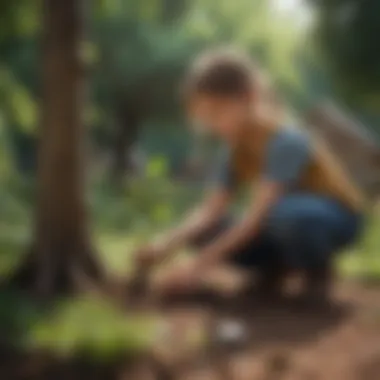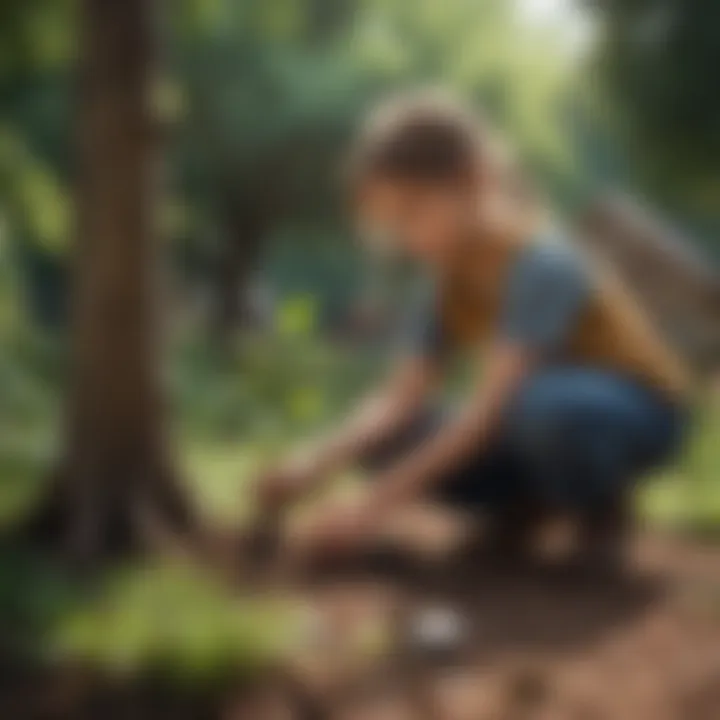Ten Practical Ways to Save the Earth for Kids


Nature Topic Overview
Fun Facts and Trivia
Learning about the environment can be exciting! Here are some fun facts:
- Trees help clean the air we breathe. One mature tree can absorb over 48 pounds of carbon dioxide per year.
- Did you know that ocean covers about 71% of the Earth? They play a key role in regulating the temperature.
- Recycling one glass bottle can save enough energy to power a computer for 30 minutes!
Imagine a quiz where you can match animals with their habitats. Kids can often get curious and learn while having fun!
Wildlife Explorations
Every place on Earth has its own wildlife. In forests, you might see deer or squirrels. In oceans, you can find colorful fish and dolphins. Here are some facts about animals and plants:
- Red foxes like to live in woods and fields. They are clever and can adapt to various environments.
- Coral reefs are living structures found in oceans. They support many marine life, providing homes for fish and other creatures.
Interactive features, like puzzles or fact sheets, can help children engage with these species. Learning about wildlife creates awareness about their importance in nature.
Environmental Awareness
Why is conservation vital? Protecting our environment ensures future generations have clean air, water, and places to enjoy nature. Here are some simple tips:
- Turn off lights when leaving a room.
- Use a reusable water bottle instead of plastic ones.
- Walk or bike for short trips, reducing air pollution.
"Each small step can lead to big changes in protecting our Earth."
When children understand their impact, they become more responsible. They can also share these tips with friends and family!
DIY Nature Activities
Getting hands-on can be fun and educational. Here are some activities for kids to do at home:
- Create a Recycling Bin: Use boxes to sort plastic, paper, and metal. Make it colorful and fun!
- Nature Scavenger Hunt: Go outside and find leaves, rocks, or flowers. Make a checklist to collect them all.
- Plant a Seed: It can be a flower or vegetable. Watch it grow and learn about the plant lifecycle.
Step-by-step guides for these activities will help children engage with the world around them. Outdoor explorations encourage curiosity and connection to nature.
Understanding Environmental Conservation
Environmental conservation is crucial for the health of our planet. It teaches us how to use natural resources responsibly and helps safeguard ecosystems. This topic emphasizes the importance of maintaining our environment for both current and future generations. When we understand conservation, we grasp how our actions impact the earth's delicate balance. This comprehension sparks a desire to engage in practices that protect our surroundings.
What is Environmental Conservation?
Environmental conservation is the act of protecting and preserving natural resources and the ecosystems that sustain life. It includes various activities, such as reducing waste, protecting wildlife habitats, and promoting sustainable practices. The aim is to ensure that natural resources are available for future generations. By adopting this approach, we can enhance the quality of life for all living beings.
Why It Matters
Conservation matters for several reasons. Firstly, it directly affects biodiversity. Secondly, it relates to climate change. Finally, it shapes the world for future generations. Recognizing these factors can motivate individuals to take action.
Impact on Biodiversity
Biodiversity is the variety of life on Earth, including different species of plants, animals, and microorganisms. Each species plays a role in maintaining ecosystem health. Protecting biodiversity helps ensure that ecosystems remain resilient. This is essential for food production, clean water, and air quality. When we preserve biodiversity, we benefit from natural resources like crops and medicines. Therefore, conserving the environment also means conserving life itself.
Climate Change Implications
Climate change refers to long-term changes in temperature and weather patterns. These changes are largely due to human activities, such as burning fossil fuels and deforestation. Understanding the implications of climate change is vital. It affects ecosystems and can lead to extreme weather events, affecting food and water security. By engaging in environmental conservation, we can mitigate these risks. Supporting renewable energy, reducing carbon footprints, and protecting natural habitats are ways to combat climate change.
Future Generations
The actions we take today will affect future generations. Children today will inherit the planet we shape through environmental policies and practices. When we conserve resources, we ensure that future generations have access to clean air, water, and healthy ecosystems. Instilling values of conservation in younger populations is critical for ongoing efforts. Teaching children about the importance of environmental stewardship will drive positive change in the years to come.
"Conservation can and should be a part of daily life, not just a requirement for future generations."
Understanding environmental conservation is not just an academic exercise. It serves as a foundation for our actions. By actively engaging with these concepts, we not only improve our planet's health but also enrich our lives and the lives of those who will come after us.
Reduce, Reuse, Recycle
The concept of reducing, reusing, and recycling is crucial for conserving our environment. It addresses the growing problem of waste by changing how we think about our consumption habits. This approach encourages us to consider the lifecycle of the products we use. By shifting our mindset, we can significantly lower the amount of waste that ends up in landfills. This, in turn, helps in saving resources and reducing pollution.
The Importance of Waste Management
Effective waste management is essential for maintaining a clean and healthy environment. It involves the process of treating solid wastes and offers solutions for recycling items that do not belong to the trash. Effective waste management conserves resources, prevents littering, and protects ecosystems.
When we manage waste well, we also contribute to the economy. Waste that is simply thrown away is wasted potential. Every object has its own value, and proper management helps us unlock that value. Each effort, no matter how small, adds to a larger goal of sustainability.
How to Recycle Effectively
To recycle effectively, one must understand the materials that can be recycled and how to separate them correctly. Education about recycling is vital in reducing contamination of recyclable materials. When items are recycled properly, they can be transformed into new products, conserving natural resources.


Identifying Recyclable Materials
Understanding what can be recycled is a first step toward effective recycling. Common recyclable materials include paper, cardboard, glass, and certain plastics. By identifying these materials, individuals can sort their waste correctly. Knowing which items to recycle is simple, but very important, as non-recyclable items may ruin entire batches of recyclables.
One key characteristic of recyclable materials is their ability to be processed and reused without significant degradation. This unique feature makes them essential in the recycling lifecycle, helping to save energy and reduce pollution.
However, improper identification can lead to more waste. When non-recyclable items are placed in recycling bins, it creates extra costs and reduces efficiency. This highlights the need for clear and accessible recycling guidelines.
Local Recycling Programs
Local recycling programs play a major role in promoting recycling in communities. They provide specific guidelines about what can and cannot be recycled. These programs make it easy for families to participate in recycling efforts. The key characteristic of local recycling programs is their ability to educate communities on proper waste disposal.
A strong feature of these programs is community engagement. Many local programs organize events or workshops that help educate residents on recycling best practices. Their success can lead to significant environmental benefits. However, one challenge can be the difference in available services across regions. Some areas may not have access to comprehensive recycling programs, which can limit effectiveness.
Creative Reuse Ideas
Creativity in reusing items can be both fun and impactful. There are countless ways to repurpose objects instead of throwing them away. For instance, glass jars can hold small items, old clothes can be turned into cleaning rags, and cardboard boxes can become organizers.
Being imaginative with reuse not only minimizes waste but also encourages a culture of sustainability. This gives items a second life and fosters an environment where everyone thinks twice before throwing things away. Creating new utilities out of discarded items inspires innovation and can be a learning experience for kids and adults alike.
In summary, reducing, reusing, and recycling helps preserve resources and saves our planet. Every small action makes a difference.
Understanding and implementing these principles benefits both the environment and communities. It shapes a future where sustainable practices are standard.
Conserve Water
Water is a vital resource for life. Conserving water stands as a key solution to environmental challenges today. Ensuring that we use water wisely can benefit our ecosystem significantly. Reducing water waste can help sustain our natural habitats and protect wildlife. Moreover, conserving water can lead to lower utility bills, which is an added personal benefit.
Simple Water-saving Techniques
Shorter Showers
Taking shorter showers is one of the simplest ways to save water. Every minute you decrease in the shower can lead to significant water savings over time. A typical shower can use around 2.1 gallons per minute. Reducing your shower time to just a few minutes less can save gallons every day.
The key characteristic of shorter showers is that they require discipline and awareness. It is a beneficial choice because it is something everyone can easily do. A unique feature of shorter showers is that it encourages a quicker and more efficient routine. The advantages are clear: conserving water helps the planet while also allowing you to save on your water bills.
Turn Off Taps
Turning off taps when brushing your teeth or washing your hands can greatly contribute to water conservation. Most people let the tap run without realizing how much water they waste. By simply turning the tap off while lathering soap, you can save gallons of water per day.
The main aspect of turning off taps is its straightforwardness. It is an easily adoptable habit. The unique feature here is the simplicity of the action. It is a good strategy because it's effortless to implement. The advantages include not only saving water but also fostering awareness about other conservation practices.
Understanding Water Scarcity
Water scarcity is a growing concern worldwide. Many regions face severe water shortages due to overuse and climate change. Understanding its causes is essential so that we can work toward solutions.
Water scarcity means there is not enough water to meet demand. This can happen in areas where people consume more water than is naturally replenished. By learning about water scarcity, children can grasp the urgency of conservation measures. It's important to engage in discussions about why saving water is crucial for both our environment and communities.
In summary, conserving water is vital for sustainability. Simple actions like taking shorter showers and turning off taps can lead to significant changes. By understanding water scarcity, everyone can play a part in this global issue.
Energy Efficiency
When we talk about saving the Earth, energy efficiency emerges as a pivotal theme. It is not just about using less energy; it’s about using energy in a smarter way. The benefits of energy efficiency extend to reducing greenhouse gas emissions, conserving natural resources, and ultimately lowering energy costs. Implementing energy-efficient practices can help address pressing environmental issues, like climate change, contributing to a healthier planet.
Why Energy Conservation is Crucial
Energy conservation plays a significant role in environmental conservation. By using less energy, we can decrease the demand for fossil fuels, which are primary sources of pollution. Furthermore, significant energy use contributes to climate change. Reducing energy consumption allows us to lower our carbon footprint. It promotes sustainability and encourages a culture of conservation, essential for future generations. The benefits of conserving energy also include saving money, leading to enhanced financial well-being for families.
Tips for Reducing Energy Consumption
Here are some simple strategies to conserve energy in daily life:
Utilize Natural Light
One effective way to save energy is to utilize natural light. This involves taking advantage of sunlight during the day instead of relying on artificial lighting. A home filled with sunlight not only reduces electricity usage but also creates a warm and pleasant atmosphere. By opening curtains or using lighter colors for walls, one can maximize sunlight penetration. The main advantage of natural light is that it does not incur any cost, making it a popular choice. On the downside, depending too much on natural light may not be feasible in all situations. Season changes can affect how much light enters, making it necessary to balance with artificial light at times.
Unplug Devices When Not in Use
Another important tip is to unplug devices when not in use. Many devices continue to draw power even when switched off, known as phantom load. Devices like chargers and TVs can waste significant energy if left plugged in. Unplugging electronics saves energy and can lower your electricity bill. This practice emphasizes the idea of taking small actions that lead to bigger impacts. However, one must consider the inconvenience of plugging devices back in when needed, though the benefits far outweigh this minor setback.
Key Takeaways: Energy efficiency is crucial in fostering sustainable habits and protecting the environment. Simple steps like utilizing natural light and unplugging devices can lead to significant energy savings.
Plant more Trees
Planting more trees is not just an act of beautifying the environment. It is essential for the overall health of our planet. Trees play a critical role in maintaining ecological balance, supporting biodiversity, and improving air quality. As urban areas expand, the need for greenery increases to combat pollution and climate change. More trees lead to a healthier planet, making it vital for every individual to contribute to this cause.
The Benefits of Trees


Air Quality Improvement
Trees significantly enhance air quality by absorbing carbon dioxide and other pollutants. They act as natural filters, capturing dust, smoke, and other harmful particles. The presence of trees can reduce the temperature in urban areas, lessening the urban heat island effect.
One key characteristic is their ability to produce oxygen through photosynthesis. Every mature tree can produce enough oxygen for several people. This benefit is crucial in highly populated areas where air quality is often compromised. The unique feature of air quality improvement through tree planting is its long-term effect. Unlike temporary solutions, trees continuously provide cleaner air, making them a popular choice in conservation efforts. However, it requires time for trees to grow and reach their full potential.
Habitat for Wildlife
Trees also provide essential habitats for many species of wildlife. They serve as homes and feeding grounds for birds, insects, and mammals. By planting trees, we are not just adding to the environment, we are enriching it. Trees play a key role in sustaining ecosystems and maintaining biodiversity.
The unique characteristic of providing habitat is that it nurtures both flora and fauna. Without trees, animal populations might decline or die off due to lack of shelter and food sources. This makes it a beneficial choice in efforts like wildlife conservation. Unfortunately, habitat loss remains a major threat due to deforestation and urbanization, which emphasizes the importance of tree planting.
How to Get Involved in Tree Planting
Getting involved in tree planting is easier than many think. There are many avenues to contribute in a meaningful way, from local community programs to school initiatives.
Local Initiatives
Local initiatives provide a direct link between community members and the environment. These programs often organize tree planting events that can involve families, friends, and neighbors.
The key characteristic of local initiatives is their community engagement. They bring together individuals and foster teamwork, while contributing to beautifying the area. Local groups often focus on urban reforestation, which adds much-needed greenery to cities.
One advantage of participating in these initiatives is the immediate impact seen on the environment. However, coordinating such efforts may require planning and effort from volunteers, which can sometimes be challenging.
School Programs
Schools are essential platforms for raising awareness about environmental issues and actions. Many schools incorporate tree planting programs as part of their curriculum. This allows children to learn about the importance of trees while actively participating in the planting process.
The key characteristic of school programs is their educational value. Children learn not only about the process of planting trees, but also about ecological principles. Engaging young students in tree planting ensures they become more aware of environmental stewardship. However, the involvement of teachers and adequate resources is crucial for the success of these programs.
"Every tree planted is a step closer to saving our planet."
By understanding how planting trees benefits the environment, and knowing ways to get involved, individuals can play a vital role in this pivotal effort. Through local initiatives and school programs, we can increase both the number of trees and awareness about conservation.
Sustainable Transportation
Sustainable transportation is an essential aspect of reducing our environmental footprint. It focuses on methods that minimize pollution and promote efficiency. This includes walking, biking, and public transportation. By using sustainable transportation, we can reduce greenhouse gas emissions, lower air pollution, and conserve resources. Adopting these alternatives offers significant long-term benefits for both the planet and our health.
Understanding the Impact of Transportation
Transportation has substantial effects on our environment. Vehicles powered by fossil fuels are major contributors to air pollution and climate change. Each year, millions of tons of carbon dioxide are released into the atmosphere as a result of driving. This pollution can lead to health problems and contribute to global warming.
When we consider alternatives to traditional vehicles, we start to see a different picture. Sustainable transportation options reduce the number of cars on the road, which also lowers traffic congestion. This means shorter travel times and a less stressful experience for everyone. Understanding the full impact of our transportation choices can lead to smarter decisions for our planet.
Alternatives to Driving
Families can explore a range of alternatives to driving. These include biking, walking, and using public transport. Each option holds unique characteristics and benefits.
Biking and Walking
Biking and walking are two of the simplest forms of sustainable transportation. They reduce the need for fuel and keep air clean. A significant advantage of biking is its positive impact on health. Regular physical activity helps maintain a healthy weight and improves cardiovascular health. On the other hand, walking is a natural and easy way to integrate exercise into daily life.
Utilizing these modes of transport is a beneficial choice because they have no direct emissions. Furthermore, biking and walking often provide a better connection to local environments. People can notice changes in their neighborhoods as they travel, which can help forge a deeper appreciation for the area. However, these options might not always be practical for long distances or during poor weather.
Public Transport Usage
Public transportation includes buses, trains, subways, and trams. This method is often less costly than ownership of a car. A key advantage of public transport is its capacity to move many people at once, lowering the number of vehicles required for travel.
The unique feature of public transport is its infrastructure. There are often established routes making it easy to navigate the city. While this option is environmentally friendly, it may not always be the most convenient. Factors such as schedule adherence and comfort can affect users' experiences. Nevertheless, when communities invest in public transport systems, it leads to reduced traffic, less pollution, and increased accessibility for everyone.
"Every time we choose alternatives to driving, we choose a healthier planet."
Support Local
Supporting local businesses is more than just a trend; it is a practical way to contribute to our environment and economy. When we buy products from local farmers, artisans, and shops, we reduce the distance goods must travel. This means less fuel consumption and fewer emissions that contribute to air pollution and climate change. Supporting local also strengthens our communities and keeps the economy vibrant.
The Economic and Environmental Benefits of Local Goods
When we choose local goods, we often discover several benefits:
- Economic Support: Money spent on local businesses usually stays within the community, leading to job creation and economic stability.
- Freshness and Quality: Local products are often fresher since they are harvested or made nearby. This can translate to better taste and higher nutritional value.
- Environmental Impact: Fewer delivery miles mean less pollution. Moreover, many local producers may use sustainable methods that help conserve resources and protect wildlife.
By supporting local goods, children can learn and feel a part of positive change. They understand that each purchase can have a ripple effect in their community.
Identifying Local Products
To support local effectively, it is crucial to know how to identify local products. Here are some tips for children and families:


- Farmers Markets: Visiting farmers markets is a fantastic way to find locally grown fruits, vegetables, and even handmade crafts. These markets often have a variety of seasonal products.
- Read Labels: Look for labels that indicate where the product comes from. Products that say "locally sourced" or "grown in [your area]" are good choices.
- Ask Questions: When shopping at stores or visiting markets, don't hesitate to ask vendors where their products come from. Most vendors are happy to share their story and how local their goods are.
Remember, when buying local, families not only find fresher products but also help reduce their carbon footprint and support the community. This simple act can significantly impact both the environment and local economies.
Wildlife Conservation
Wildlife conservation is crucial in maintaining biodiversity and the health of our ecosystems. Every species plays a role in its environment, and the loss of even one can have serious ripple effects. The protection of wildlife preserves the intricate balance of nature, which is essential for the survival of countless other species, including humans. Some benefits of wildlife conservation include sustaining food chains, preserving genetic diversity, and maintaining habitats that protect various organisms.
In this era of rapid industrialization and environmental change, the role of wildlife conservation becomes even more pressing. It provides a framework that encourages responsible stewardship of our planet. Involving children and communities in wildlife conservation efforts can foster a deeper understanding of environmental interconnections that usually go unnoticed.
Understanding Ecosystems
An ecosystem consists of living organisms, including plants, animals, and microorganisms, interacting with each other and with their physical environment. Understanding ecosystems involves recognizing how these components depend on one another for survival. A healthy ecosystem provides clean air, water, and food, while also contributing to natural processes like pollination.
Ecosystems vary widely across the globe—from lush forests to arid deserts. Each plays a unique role in the health of our planet. For example, rainforests act as vital carbon sinks. This knowledge reinforces the need to protect such environments and the species that inhabit them. When kids learn about ecosystems, they can appreciate the complexity of life and their role in it.
How Kids Can Help Protect Wildlife
Kids can play a significant role in wildlife conservation. There are various ways they can contribute to protecting our planet's species.
Participate in Local Clean-ups
Participating in local clean-ups is an active way to contribute to wildlife conservation. This activity primarily targets litter in habitats critical to various species. Litter can be harmful or even deadly to wildlife, as they may mistake it for food or become entangled in it. By organizing or taking part in clean-up initiatives, children learn the importance of maintaining a clean environment.
The key characteristic of local clean-ups is their community focus. This encourages teamwork and raises awareness about the consequences of waste on ecosystems. The unique feature of these clean-ups is that they instill a sense of ownership and responsibility towards local habitats. The advantage is that kids see the immediate impact of their efforts, fostering a deeper connection to nature.
Learn about Endangered Species
Learning about endangered species is another notable way for kids to protect wildlife. Understanding why certain species are at risk can lead to informed actions and advocacy for their preservation. The key characteristic of this educational aspect is its ability to raise awareness about biodiversity loss.
In this article, learning about endangered species serves as an essential tool in wildlife conservation. Kids can champion various initiatives or volunteer for organizations dedicated to protecting these animals. Unique features include creating presentations, reading books, and participating in community discussions about endangered wildlife.
While this may seem less direct than participating in clean-ups, it has long-term advantages. Children who learn about endangered species are more likely to grow into informed adults who prioritize conservation efforts.
"Educating children about wildlife develops their empathy toward all living organisms and inspires them to take action for their protection."
Advocacy and Awareness
Advocacy and awareness are critical components to save the Earth. By sharing knowledge, people can influence others and create a ripple effect that fosters positive change. The goal of this section is to highlight how educating ourselves and others ensures a sustainable future. When individuals understand the value of conservation, they are more likely to take action. This engagement can lead to widespread change that impacts communities, ecosystems, and ultimately, the planet.
The influence of advocacy goes beyond personal actions. When communities rally behind a cause, it can attract attention to environmental issues. This awareness can, in turn, lead to stronger policies that promote sustainability. Schools, local orgnizations, and families can each play a role in spreading this message. Education serves as the foundation for informed decision-making.
The Role of Education in Conservation
Education plays an essential role in environmental conservation. When children learn about their impact on nature, they develop a sense of responsibility. Schools should incorporate environmental studies into their curriculum. This gives kids the knowledge they need to make informed choices. Topics such as climate change, pollution, and recycling can help them understand the consequences of their actions.
Furthermore, engaging students in hands-on activities, like gardening or environmental projects, creates real-world connections. Experiencing nature firsthand makes students more aware of its fragility. This understanding fosters a deep appreciation for the environment, preparing the next generation to be effective stewards of the Earth.
Ways to Raise Awareness among Peers
Raising awareness is a shared responsibility among peers. Here are some simple yet effective ways to encourage others:
- Start a Club: Form a club focused on environmental issues. This can be a school project or a community initiative.
- Social Media Campaigns: Use platforms like Facebook to spread messages about conservation. Engaging posts can reach many people.
- Organize Events: Host events such as clean-up days or tree planting activities. These events can create a sense of community and collective action.
- Share Books and Resources: Recommend books or documentaries that highlight environmental topics. This helps peers learn and discuss issues together.
Remember, knowledge is power. When young people take the initiative to learn and promote environmental awareness, they can change the world.
Ultimately, advocacy and awareness are foundational for a healthier planet. Through education and collaboration, children and their communities can work together to make a significant impact. Every action, no matter how small, contributes to a larger effort towards sustainability.
Future as Stewards of the Earth
Our planet's future heavily relies on the younger generation. They are not just the leaders of tomorrow; they are the changemakers of today. Young people have the unique ability to influence their families and their communities about important environmental issues. Encouraging active participation in conservation efforts promotes a sense of ownership and responsibility towards the Earth.
This section delves into how engaging children in environmental stewardship shapes their understanding of how their actions impact the world. It highlights the specific responsibilities that come with being a steward of the Earth and the significance of making sustainable choices.
The Responsibility of the Younger Generation
Children today will inherit the Earth and its challenges. They hold the key to a better future if they learn early about environmental issues. Understanding climate change, resource depletion, and biodiversity can empower them. They can learn to value nature and understand that every small action counts.
Here are a few key responsibilities they can adopt:
- Educate Themselves: Knowledge is power. Children can learn about ecosystems and conservation methods. Resources like Wikipedia or Britannica can provide helpful information.
- Participate in Efforts: Joining local groups or school initiatives helps children to see the real impact of their contributions.
- Lead by Example: Many children influence their home life through their actions. By practicing recycling or reducing waste at home, they encourage family members to do the same.
Building Habits for Sustainable Living
Sustainable living is about adopting practices that protect the environment while meeting our needs. For children, habit formation is essential. Introducing simple, but effective habits can lay the groundwork for a sustainable future.
Here are some practices that can be incorporated into daily life:
- Reduce Plastic Use: Opting for reusable bags, bottles, and containers helps decrease reliance on single-use plastics.
- Compost Organic Waste: Learning how to compost food scraps allows kids to see waste recycling in action.
- Conserve Energy: Simple actions, like turning off lights when leaving a room, demonstrate that energy conservation can be easy and rewarding.
Instilling these ideas can promote environmentally friendly attitudes from a young age.
"The Earth is what we all have in common." – Wendell Berry
Sustainable living isn't just a topic for adults; children play a vital role. Encouraging them to adopt these practices ensures that they grow up with a strong sense of environmental responsibility. It also fosters a community where every age can contribute towards the stewardship of our planet.







